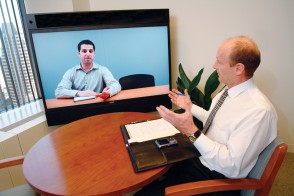6 Document-Related Challenges with Remote Depositions
In the most recent global economic downturn, companies across the globe looked to cut back on travel expenses as one of the easiest ways to cut costs. This was enabled by the rise in internet speeds and new technologies. Law firms of course, were also significantly affected by the economy, and one result has been a steady increase in remote depositions. More and more court reporting firms offer remote depositions as not just an additional offering, but as part of their core offering. Nevertheless, remote depositions are still the exception to the rule. Why?
Most litigators are well aware of the pros and cons of conducting a remote deposition. Even the litigators who are comfortable conducting remote depositions deal with many challenges. Specifically with regards to document exhibits, there are primarily 6 main challenges with remote depositions that hinder its adoption:
6 Document-Related Challenges with Remote Depositions:
- Passing documents. Both prior to and during a deposition, the lead counsel doesn’t want to let the opposing counsel or witness to see key documents too early. Doing so is sometimes no different than revealing your hand at a poker game. Prior to a deposition, this can be alleviated by sending the documents to the court reporter. However, during the deposition, a litigator relying on a remote court reporter to hand the witness the documents definitely loses control over access to the documents. The witness and opposing counsel may have an uncomfortable amount of time to review and digest the documents before the lead counsel gets to question the witness. This definitely limits a litigator’s strategic and tactical options.
- Current solutions are patchwork. Litigators conducting remote depositions currently have to rely on a patchwork of solutions. They may use Skype to see the witness, have their notes written down or in a document editor on their computer, share their screen with another program to reveal documents (or worse, rely on the court reporter to reveal the documents).
- Managing large number of documents. If there are only a handful of document exhibits, they’re easily handled. But if there are more than a handful, sorting through and retrieving the right documents can be very time intensive and frustrating.
- Control of the witness. In person depositions give the litigator much more control over what the witness is viewing at any given time. The witness has in front of him/her exactly what the lead counsel wants. If a witness can’t find something on a document (or is playing dumb), the lead counsel can reach over and point to the exact spot on the document that the witness needs to be looking. This is impossible in a remote deposition.
- Modifications of the exhibit. In a normal deposition, marks by the witness can be easily and rapidly seen by all present. With remote depositions, this control of the witness is much more difficult. The court reporter has to hold up the modified document to the camera so that remote participants can see the annotation. Hardly an elegant solution.
- Getting on the same page. In a remote deposition, it is difficult for the attendees to see exactly what the witness is looking at, without looking over his/her shoulder or projecting the exhibits onto the wall.
The Solution:
Fortunately, many of these challenges with remote depositions can be solved with the application of the right technology. For example, AgileLaw’s paperless deposition solution is an ideal tool to mitigate or eliminate many of these challenges. Though it was not created specifically for remote depositions, its features give the litigator conducting remote depositions an enormous amount of control over the witness and the documents being used. Specifically:
- Passing documents… AgileLaw allows a litigator to keep documents hidden until they’re revealed in a deposition
- Current solutions are patchwork…AgileLaw combines current patchwork solutions into one elegant platform
- Managing large number of documents…key documents are a click away with AgileLaw
- Control of the witness…litigators using the AgileLaw platform actually have MORE control over the witness than the litigator using paper
- Modifications to the exhibit. With AgileLaw, everyone in the deposition sees instantly on his/her computer screen what the witness is doing.
- Getting on the same page. With AgileLaw, seeing what the witness is viewing, for any attendee, is as easy as the click of a button.


Comments
Attorneys must not rely on the court reporter to handle documents during the deposition. The court reporter’s hands cannot leave the stenotype keyboard whenever someone is speaking. In order for the court reporter to handle documents/exhibits, counsel must agree to go off the record, which might endanger losing something critical being said getting into the record.
Signed,
A court reporter.
Leave a Reply